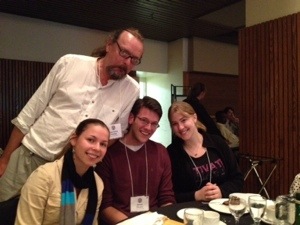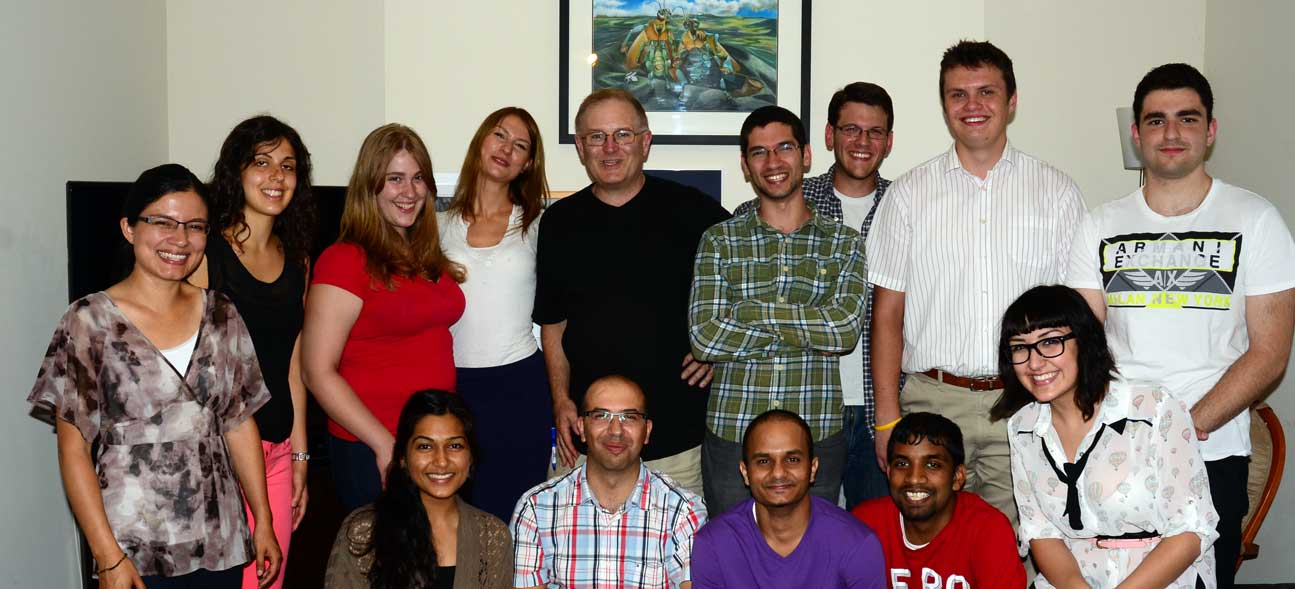I would like to welcome our new Postdoc Dr. Alivia Dey to the lab. Alivia obtained her PhD from the University of Toronto where she studied the population genetics of Caenorhabditis with Dr Asher Cutter. Check out Alivia’s recent PNAS paper on hyperdiversity in nematodes! She will be working on honey bee population genomics here.
Welcome Alivia!
Amro


Bahar with Dr. Sam Benchimol, Chair of the Department of Biology
Congrats to Bahar Madani, currently an honour thesis student in the lab. She won the Biology Department’s William and Marguerite Davey Award for a biology student that shows that greatest promise as a researcher. Way to go Bahar!
Amro
Drop by and say Hi!
Departmental Seminar @ Iowa State University, Dept. Ecology, Evolution, and Organismal Biology, Dec 5th 2013
Seminar @ Gordon Research Conferences: Genes & Behavior, Galveston TX, Feb. 9-14, 2014
Public Lecture @ Royal Canadian Institute for the advancement of science, Toronto, ON, Feb. 16 2014
Amro
Very happy to announce that Brock Harpur was awarded the entomological society of Canada’s president award for the best student talk in insect physiology and molecular biology. Nadia Tsvetkov received the runner-up award for best talk in insect behavior and biological control. Rounding off the awards was another York U’s grad Mariya Cheryomina (supervised by Laurence Packer and Bridget Stutchbury) who received the runner up award for best poster. Congrats all!
Amro

Laurence Packer (top) with Mariya, Brock, and Nadia
Can you spot Brock, Daria, Jen, Lior and Bahar. They are participating in Diane Borsato’s Your Temper, My Weather: a 4 hour – 100 beekeeper group meditation for Toronto’s Nuit Blanche

You can’t do a great citizen-science project without great citizens! We recently asked Beekeepers to collected a few workers from their colonies for a national survey of the genetics of Canadian honey bees. We’ve received back more than 500 bees from every province; we’ve even got bees from Yukon! Check out one beekeeper’s innovative sampling protocol here. Thanks Greg.
Amro
July was Dr. Clement Kent’s last month as postdoc in the lab; he will start a new position as a Senior Scientist at Howard Hughes Medical Institute’s Janelia Farm Research Campus – probably one of the best places in the world to do neuroscience at the moment. Clement was the first member to join my lab; he joined as a NSERC Postdoc fellow. Congrats Clement; you’ll be missed!

Farewell Clement!
top L-R: Maria, Catherine, Nadia, Daria, Clement, Jonathan, Brock, Phil, Lior
bottom L-R: Keshna, Amro, Ash, Kajendra, Bahar
Hello.
We are looking for beekeepers to participate in a research project on the genetics of Canadian honey bee stocks funded by the Canadian Honey Council’s Bee Research Fund. If you are interested, sign up at the following website www.yorku.ca/honeybee Participation is easy! We will send you a labeled prepaid envelop with collection tubes, and you send it back to us with a few dead bees from your yard. We are hoping to sample honey bees from coast to coast; commercial beekeepers, bee breeders, and scientists / hobbyists are welcome.
Please see www.yorku.ca/honeybee for more information and to sign up.
Thanks for helping us with our project,
Amro Zayed
Postdoctoral fellow Dr. Clement Kent was interviewed today on CTV’s Canada AM regarding the recent honey bee deaths in Ontario.
I was interviewed later on the day on CBC’s 5 pm News in Toronto; Nadia, Bahar and Phil make cameo appearances.
De la Rúa et al. raised some comments about our recent article showing that management enhances genetic diversity in honey bees. Their comments, along with our response have been published online in Molecular Ecology. We stress that admixture does enhance genetic diversity in managed bees.
Conserving genetic diversity in the honeybee: Comments on Harpur et al. (2012)
Pilar De la Rúa, Rodolfo Jaffé, Irene Muñoz, José Serrano, Robin F. A. Moritz and F. Bernhard Kraus
Article first published online: 28 MAY 2013 | DOI: 10.1111/mec.12333
and
Admixture increases diversity in managed honey bees: Reply to De la Rúa et al. (2013)
Brock A. Harpur, Shermineh Minaei, Clement F. Kent and Amro Zayed
Article first published online: 9 MAY 2013 | DOI: 10.1111/mec.12332




